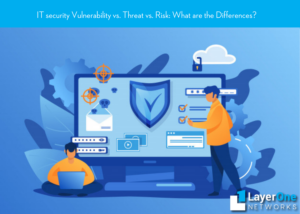Data and data protection are a crucial part of all businesses. Customers demand to have high security of their personal data due to cyber attacks. If you don’t keep it secure, you will lose in business because they expect rigid security before doing the business.
In order to have high security, you can contact security services at corpus Christi to handle issues of your data that can potentially impact your business. These issues refer to threat, vulnerability, and risk. They are distinct technical terms but with different meanings and different implications.
Threat + Vulnerability = Risk
These terms are inherent to cybersecurity, but enterprises often get confused to understand their meanings. So let’s know further what is the difference between these terms and what they actually meant.
What is a Threat?
The threat is defined as a newly discovered incident that can harm the company’s system or overall.
There are three types of threats :
Natural threats:
Act of nature that can be unpredictable in duration and impact. Such as hurricanes, floods, or tornadoes.
Intentional threats:
An act that can be done intentionally by a threat group to compromise the IT company. Examples include injecting malicious code, stealing an encryption key to access the credentials of the user.
Unintentional threat:
It is most often human error. It includes employees mistakenly accessing the wrong information or leaving the door of the IT server unlocked.
How to reduce it?
Threats are uncontrollable and often difficult to identify in advance. You need to always stay updated with the latest cyber threats and the tools that can reduce them. Some of the most common attacks are:
- Dos and DDoS attack.
- Man in the middle attack
- Password attack (like brute force attack)
- SQL injection attack
Data breaches are the biggest cause that includes improper password management and unpatched software. Consult high-security service at Corpus Christi to stay away from such breach attacks.
Now look at vulnerability and know how it interacts with threats.

What is vulnerability?
Vulnerability refers to known resources’ weaknesses and can be exploited by one or more than one attacker. It is a known issue that allows the attacker to succeed and exist in the system.
Example of vulnerability :
Suppose a team member resigns and you forget to disable their accounts, change their logins, and remove their card information from your business. In that case, it will leave the business to both intentional and unintentional threats.
How to reduce it?
Keep license and security patches updated:
Technology providers who manage IT security services give regular updates to repair patches, so ensure that you keep your application software updated with the latest version and make sure your license application is current.
Maintain a strict policy:
Keep your data protected with encrypted passwords locked away. Also, make sure that your data has backed up and you have an emergency plan in the event of a system breakage or data breach.
Reduce it caused by human error:
It can be done by restricting access. Restrict employee access or the right to change the information.
Now you have understood the vulnerability, and it is the first step to manage your risk.
Calculate risk based on threat and vulnerability
Risk is known as the potential for loss when a threat exploits a vulnerability. The organization will look at what causes potential harm to a system or overall business.
It includes loss of privacy, financial loss, phishing attacks, and legal implications. Organizations go to an extent to transfer and avoid risks.
How to reduce risk?
A risk assessment is the first line of defense to reduce risk. To be prepared well for the unpreventable risk, an inspection of risk is necessary to baseline the attack surface. Any business has to invest in a risk management program to understand well how to measure risk. Security leaders who manage the data security solution are trying to solve for actual risk when evaluating what can be reduced or avoided.
After risk assessment, if you are finding that you are not able to treat all known risks fully. At that stage, it is essential to determine the level of risk that your organization can tolerate without compromising. So now you can run a risk treatment plan to manage these threats and create a risk assessment plan and stick to it.
Cyber threats can happen at any time and increase hackers using technical and organization skills. An organization that makes security a priority will consult security services at corpus Christi across the enterprise and better manage the data they process.
Conclusion:
All three threats, vulnerability, and risks are different. They are paying out a lot of resources for their business, but many organizations don’t know the differences between them. A threat involves malicious acts aimed to destroy data or disturb operations. Threats are generally made up of denial of service attacks and data breaches. Vulnerabilities are flaws in systems that are open to potential attacks. Vulnerability will leave the system open to threats. While risk represents the harm that it causes to systems. Terms are different, but they are interconnected when it comes to cybersecurity.

